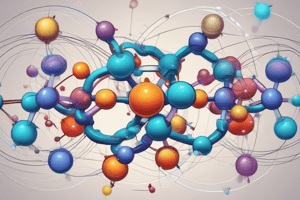Podcast
Questions and Answers
What is the result of sodium donating an electron to chlorine?
What is the result of sodium donating an electron to chlorine?
- The sodium atom becomes more stable with an incomplete 3n shell
- The chlorine atom loses an electron to become more stable
- A covalent bond forms between the atoms
- A sodium ion and a chloride ion are formed, each with a complete outermost shell (correct)
What is the term for ions like sodium, potassium, and calcium that are necessary for nerve impulse conduction and muscle contractions?
What is the term for ions like sodium, potassium, and calcium that are necessary for nerve impulse conduction and muscle contractions?
- Covalent molecules
- Soluble salts
- Ionic compounds
- Electrolytes (correct)
What is the type of bond formed when atoms share one, two, or three pairs of electrons?
What is the type of bond formed when atoms share one, two, or three pairs of electrons?
- Covalent bond (correct)
- Ionic bond
- Hydrogen bond
- Electrostatic bond
What is the result of the loss of an electron by one atom and the gain of an electron by another atom?
What is the result of the loss of an electron by one atom and the gain of an electron by another atom?
What determines the strength of a covalent bond?
What determines the strength of a covalent bond?
What is the arrangement of ions in a crystal like table salt?
What is the arrangement of ions in a crystal like table salt?
What is the primary reason why a sodium atom loses an electron to form a sodium cation?
What is the primary reason why a sodium atom loses an electron to form a sodium cation?
What is the term for the process of one atom losing an electron and another atom gaining that electron?
What is the term for the process of one atom losing an electron and another atom gaining that electron?
What is the suffix used to name anions?
What is the suffix used to name anions?
Why does chlorine tend to gain an electron to form a chloride anion?
Why does chlorine tend to gain an electron to form a chloride anion?
What is the charge of a sodium cation?
What is the charge of a sodium cation?
What is the purpose of electron gain or loss in atom formation?
What is the purpose of electron gain or loss in atom formation?
Flashcards are hidden until you start studying
Study Notes
Ions and Ionic Bonds
- Atoms can gain or lose electrons to form ions, which are charged particles, to achieve a more stable state.
- Ions come in two types: cations (positive ions) formed by losing electrons and anions (negative ions) formed by gaining electrons.
- Cations are named as they are, while anions are named using the ending "-ide" (e.g., chloride).
- Electron transfer occurs when one atom loses an electron and another atom gains it.
Sodium and Chlorine Example
- Sodium (Na) tends to lose its one electron to form Na+, as it's energetically favorable to donate one electron than to find seven more to fill its outer shell.
- Chlorine (Cl) tends to gain one electron to form Cl-, as it's easier to gain one electron than to lose seven to fill its outer shell.
- Sodium transfers one electron to chlorine, resulting in the formation of Na+ and Cl- ions, which satisfy the octet rule.
Ionic Bonds
- Ionic bonds are formed between ions with opposite charges, such as positively charged sodium ions and negatively charged chloride ions.
- The attraction between oppositely charged ions results in the formation of compounds like sodium chloride (table salt).
- Ionic compounds, like table salt, consist of many ions arranged in a repeating, predictable 3D pattern (a crystal).
- Electrolytes, including sodium, potassium, and calcium, are necessary for nerve impulse conduction, muscle contractions, and water balance.
Covalent Bonds
- Atoms can also become more stable by sharing electrons, forming covalent bonds.
- Covalent bonds are more common than ionic bonds in the molecules of living organisms.
- Covalent bonds can be single, double, or triple, depending on the number of electron pairs shared between atoms.
- The more electrons shared between two atoms, the stronger their bond will be.
- Covalent bonds are key to the structure of carbon-based organic molecules like DNA and proteins, as well as smaller inorganic molecules like H2O, CO2, and O2.
Water Molecule Example
- A single water molecule (H2O) consists of two hydrogen atoms bonded to one oxygen atom.
- Each hydrogen atom shares an electron with oxygen, and oxygen shares one of its electrons with each hydrogen.
- The shared electrons split their time between the valence shells of the hydrogen and oxygen atoms, giving each atom a stable configuration.
Studying That Suits You
Use AI to generate personalized quizzes and flashcards to suit your learning preferences.




